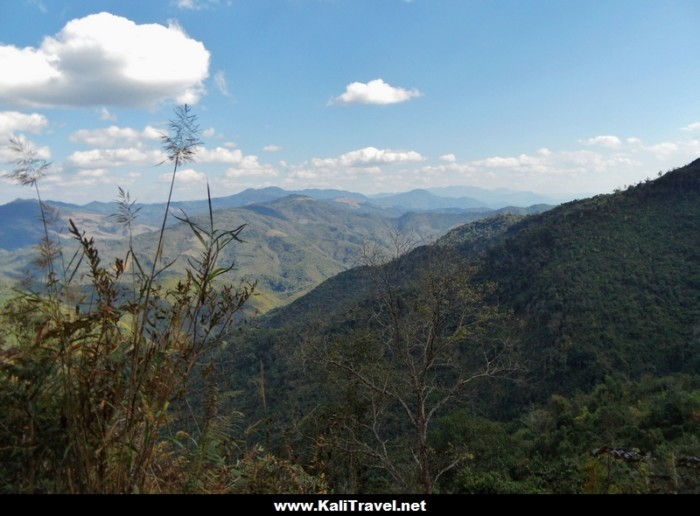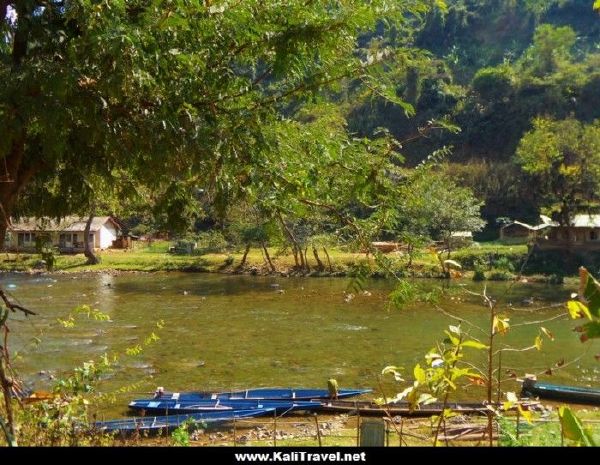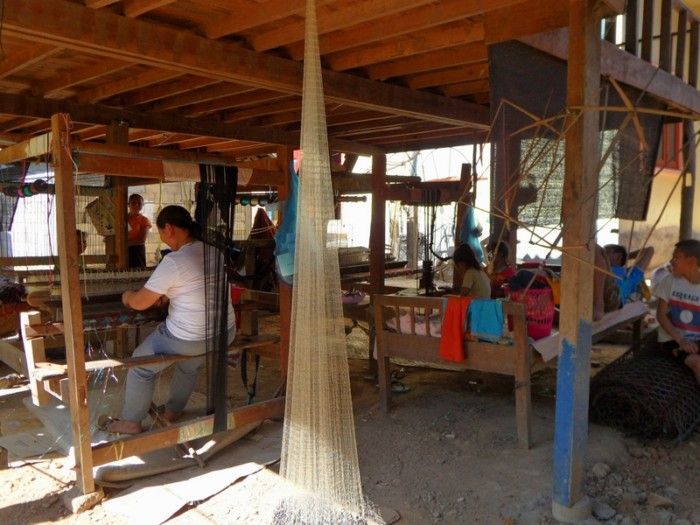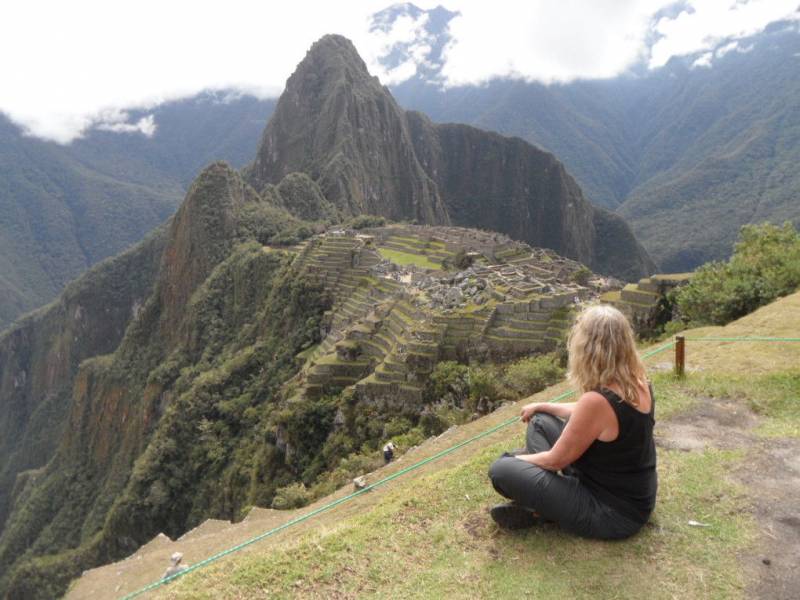How to get to Vieng Xai – a fascinating 1 day visit to the secret Cave City in remote Northeast Laos.
“The minibus leaves Phonsavan and the mysterious Plain of Jars behind in the morning mist, zipping along the tortuous mountain road towards Sam Neua, almost a day’s ride away in remote northeastern Laos. Passengers are mainly locals intermingled with a handful of independent travellers…not tourists or holidaymakers, just travellers with the desire to see a dot on the map called Vieng Xai, a small town with a compelling history renamed ‘Victory City’…”
(Saga of a scooter ride to Victory City).

1 day visit to Vieng Xai (and how to get there)
Phonsavan to Sam Neua
A smart-looking Canadian couple, a pretty US backpacker, a husband and wife speaking French (she’s from Reunion Island, how interesting), Juan and I, are the only foreigners aboard the minibus from Phonsavan to Sam Neua. We get chatting, shamefully too lazy to break the language barrier with the Laotians aboard. Like us, this part of their trip is on spec, an afterthought on an itinerary which misses out the usual Lao haunts of Vieng Vieng or Vientianne.
There’s no organized tour available to Vieng Xai and sparse information on the internet about reaching this little-visited region. The pine clad mountainside and sheer rocky gorges slip by, the landscape is much the same as our previous journey from Luang Prabang to Phonsavan and passes few inhabited places.

Leaving the Plain of Jars plateau behind the road dips towards Houaphanh Province. The bus stops en route in the main square of a riverside village, barely giving driver and passengers time to get lunch at one of the roadside eateries. It’s a chance to wander off, to see the river where men fish in handcrafted canoes and families sit weaving in the under-build of their ramshackle homes; a fascinating scene to watch but briefly; the bus toots a horn of imminent departure.

Arriving in Sam Neua
Phoutanou bus station is at the top of a very dusty hill overlooking Sam Neua. Samantha pulls on her backpack and woolly hat and traipses down the steep slope, the rest of us share songthaews, the noisy ‘auto-rickshaws’ so popular in Asia, down to the River Xam which divides the small valley town ‘Xam Neua’.
There’s a row of unpretentious hotels along the riverfront, the sort where businessmen tend to stay – it’s cheaper to find something on arrival than to book online. The first guesthouse I try smells damp, but the family run hotel next door is fine, quite luxurious for us on a long-term travel budget it even has a lift, and costs a pittance.
Late afternoon and we need a moped for the next day to get to Vieng Xai and the cave city. What seems a bright idea turns into a challenging mission. Few people understand English, the hotel is no help and the tourist information office is shut. We find a bike workshop and a young guy points us around the block.
There are several small shops and a food market with a display of fresh fruit, vegetables and meat (bamboo rat and possibly squirrel). Sam Neua doesn’t have a vehicle hire shop, and it’s not hot on eateries either. The locals eat at home, businessmen in their hotels or at the largely empty, pricey Chinese restaurant.
There’s also a small café bistro with a pocket-friendly menu, the Dannao Meuang Xam Restaurant; the last item listed is a moped for hire…yes, really. When the owner-come-chef finishes cooking for the evening, we agree a price. Awesome! Another Beer Lao, then we’d better get back to our lodgings.
The night air rings with the continual sound of loudspeakers -like those old war sirens on a pole- and to me with my shameful lack of Lao it seems like a victory speech. Tomorrow we are going to Vieng Xai, to ‘Cave City’ where the victorious Pathet Lao revolutionaries won a ‘secret war’.
Scooter ride from Sam Neua to Vieng Xai
The scooter ride to Vieng Xai is an adventure in itself. The main road leads up and out of Sam Neua past the new industrial estate (China is investing big-time in the region). The route’s clearly marked but the moped is limited on power and visions of pushing it back to town spring to mind; a combination of positive thinking and sheer luck do the trick as we happily wind our way through the mountains.
The freedom of discovering a country at your own pace is the most exhilarating sensation in the world!
Along the way to Vieng Xai the countryside flattens out to reveal farms and small lakes. Once again, these are deforested lands with bomb crater water holes resulting from the IndoChina war, although the landscape is so peaceful and scenic it is difficult to believe.
Juan and I chug along a lane to investigate, stop for awhile to ‘talk’ to a farmer and his family (a few smiley nods and gesticulations anyway). It’s interesting to see their fishing lagoon, arable crops and some munching cows in an adjoining field. Later we learn that people only raised dark-coloured livestock during the conflict, and worked the rice fields after dark, to keep the area camouflaged from the fighter planes at night.
Huge karst rocks frame the skyline beyond the farming land.
Arriving in Vieng Xai
Back on ‘speedy scooter’ we continue towards Vieng Xai. It’s here where the Pathet Laos set up central control in a network of caves that concealed some 24,000 people during the last IndoChina war -the high command, their families, guards and entourage, along with soldiers and villagers caught up in the turmoil years, from 1964 right up to 1973.
The ‘new’ town sprawls around a central lake -modest wood chalets, a restaurant or two, snack shops, and a new monumental temple.
Visiting Vieng Xai ‘Cave City’
Flat paved roads lead to the Cave information visitors centre. Guided tours of ‘Cave City’ are programmed twice daily; no one is around at noon. A handful of travellers trickle in and the ticket office opens in time for the afternoon pass. Juan and I follow the guide on her scooter and the others pedal behind on hired pushbikes. The various caves are some distance apart.
In English, she explains how during the war, scouts were sent out across the region to hunt for the perfect secluded place to install a command base for the politburo. The limestone karst formations are hollow inside and the secret cave city came into being. Each leader had separate cave quarters for tactical reasons, and these are now open to the public.
The friendly local guide -her uncle was born and lived inside the underground complex- conducts the tour, showing visitors around and making sure they don’t get lost, although it’s actually a professional audio tour, a most remarkable and poignant experience.
When the war ended, the PDR leaders had large wooden chalets built outside their caves, and these are now surrounded by memorial gardens.
The narrow entrance-ways to the caves are concealed under overhanging rocks. The recesses are divided into rooms connected by tunnels – living quarters for the generals and their wives, children’s bedrooms, guards’ quarters, dining room, study, bathroom, etc., and even a garage.
The beds, tables and some utensils are still on display but you can hardly imagine life in these bare, stark surroundings.
A much bigger cave complex is where the villagers lived…for 9 hostile years. There are dormitories, kitchens, mess rooms, a ‘hospital’ and a large theatre where entertainment kept people sane and the highlight of life was a wedding -that and watching the evening display of tracer gun ammunition across the sky, an eerie ‘firework’ display.
All this and much, much more is narrated on the extraordinary Narrowcasters audio guide which includes interviews with survivors.
You definitely need a positive traveling mindset to visit Vieng Xai.
Some of the excerpts stick in my mind, like the widow of a prominent resistance fighter who remembers him as a ‘gentle man’, the compelling ideology that fueled the revolution and the crude reality that followed. And the haunting story of Sipanh Vangdeuayang, a 10-year-old boy whose grandfather died when a bomb hit their home in nearby woods.
“My grandmother was not hurt and she was shouting angrily at the planes, ‘Is there something wrong with your eyes? Are you blind? Why are you dropping bombs on people? I’ve lived a good and honest life, why don’t you shoot at your own house?’ She was crying and mumbling at the same time.”
The leaders had their dreams of independence from the colony, a better education and life for the poor in a world where everyone is equal but something went dreadfully wrong along the way. The Pathet Lao won their war, but at what price to local families who were forced to join the rebels? Victorious Victory City is peaceful now, the people pleasant and polite.
Sipanh Vangdeuayang went on to become Director of the information centre and he would like to promote Vieng Xai, not to mass tourism no, but to people who are genuinely interested, to make sure the true history of this place, until recently classed top secret, is never forgotten. In the future it should be easier to get here!
The others head for the bus stop, while Juan and I scooter back to Sam Neua. Hungry after an adventurous day, we head for the moped owner’s restaurant, the food is decent and it’s a laid-back. The other travellers arrive late grinning, the return bus from Vieng Xai never came along so they’ve just hitched a lift on a lorry – it’s hilarious, our old bike might lack power but it did the trick.
The morning sun glints off the river in front of the hotel where a tuk tuk is waiting to take us up the hill to the Phoutanou terminal, it’s a cheap fare. The 8 am bus is going to Vietnam, and hopefully Hanoi…
Useful Info for Getting to Vieng Xai
See this link for the full Vieng Xai Cave City audio script it makes interesting reading.
Getting to Sam Neua (Houaphanh Province):
By plane from Vientiane with Lao airlines.
Daily bus service from Luang Prabang, Phonsavan, Vientiane, and Thanh Hoa (Vietnam).
Visas:
Leaving Laos at the Nam Soi-Nameo International border – Check your visa requirements before travelling to Vietnam. Visas are not issued at this crossing so should be obtained in advance from a Viet Consulate in Luang Prabang, Vientiane or Savannakhet. Citizens from a number of countries, including Europe, are currently allowed into the country on a 2 week visa-free basis (you should have proof of an onward flight/bus ticket to leave the country).
Entering Laos: If you are eligible for the 1 month visa-on-arrival to ENTER Laos you CAN get this at Nam Soi-Nameo border.
Sam Neua Tourist Information Bureau: Open Mon-Fri 8.30am to 12, 1pm to 4pm.
Vieng Xai Cave Visitors Centre: Open every day.
More information on travel in Laos: www.tourismlaos.org or www.ecotourismlaos.com
Related Posts on Laos
From Sam Neua we travelled on to Vietnam.
Sam Neua to Hanoi – Laos to Vietnam direct bus
The Sam Neua / Vieng Xai ‘direct’ bus to Hanoi.
How to cross from Northeast Laos into North Vietnam at the Nam Soi-Na Meo border. Laos is an adventure no doubt about it, from the moment you cross the Thai border over the Friendship Bridge at Huay Xai…
Here are more posts on our travels through Laos, an incredibly interesting but little-known land in the heart of South East Asia:
North Thailand-Laos border crossing for the Mekong Slow Boat
How to cross the North Thailand-Laos border at the 4th Mekong Friendship Bridge.
Crossing the border in North Thailand over the 4th Friendship Bridge to Laos and on to Huay Xai to get the 2-day Slow Boat down the Mekong River. Sounds complicated? Not at all, see how we did it.
Laos: 2 day Mekong slow boat from Huay Xai
Discovering Laos – Huay Xai and a 2 day slow boat down the Mekong River to Luang Prabang. Huay Xai is a small river town in the remote Bokeo province of northern Laos. A peaceful setting in the middle of a vast jungle, Ban Houayxay (as it is known)…
Laos: 3 Days in Luang Prabang UNESCO World Heritage Site
Travelling through Laos – 3 days in Luang Prabang.
Luang Prabang is a UNESCO World Heritage landmark famous for its Buddhist sites and French Colonial mansions. One of the largest cities in Laos (Vientiane is the capital) it has a small-town feeling and looks just like a period film…
Laos: 3 days in Luang Prabang (sites unvisited by tourists)
3 days in Luang Prabang – unvisited places and sites not yet discovered by tourists. Luang Prabang unvisited.
Behind the genteel glamour of colonial Luang Prabang there’s a different world waiting to be discovered. Around the corner from the World Heritage Sites, or across on the opposite bank of the Mekong…
Laos: 3 Days in Luang Prabang (Alms Ceremony + Kuansi Falls)
Watching the Dawn Alms Ceremony and an afternoon at Kuansi Falls, on the last of our 3 day adventure in Luang Prabang.
The last day in Luang Prabang is memorable…and that’s not an exaggeration! “My phone alarm goes off at 5 am and I sneak out of our room…
Laos: 1 day Guide to Plain of Jars and Ban Napia, Phonsavan
1 day Guide on visiting the Plain of Jars and Ban Napia ‘spoon village’ near Phonsavan in Northeast Laos.
The private minibus ticket is not much dearer than getting a standard bus which covers the route from Luang Prabang to Phonsavan….
Discover the World with

